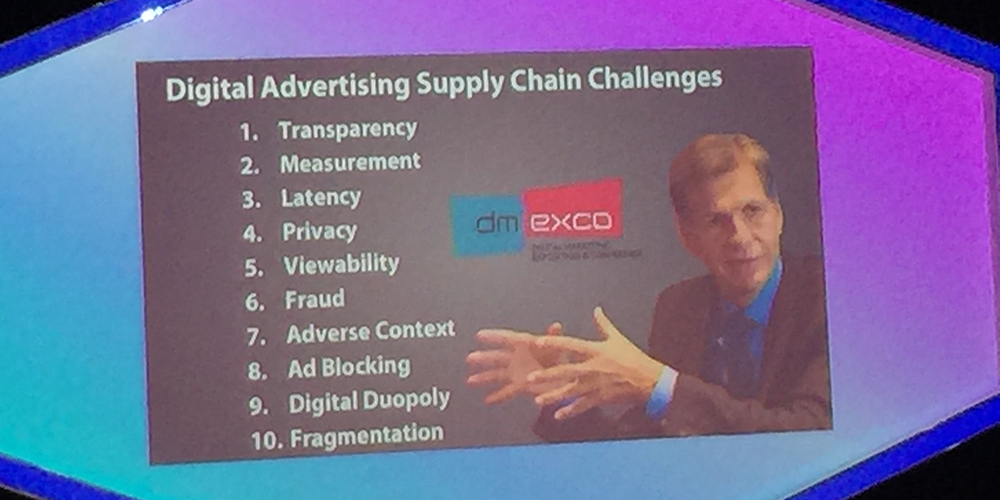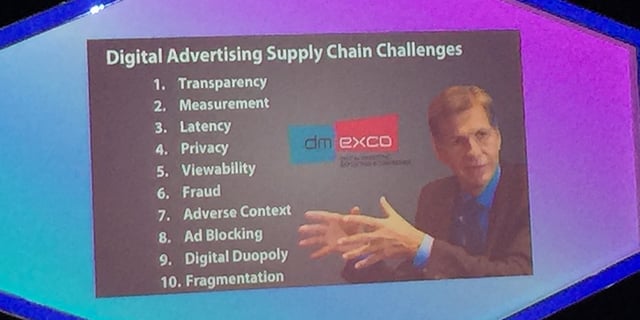
Marc Pritchard, the oft-cited Chief Brand Officer at P&G and perhaps the most outspoken person in terms of digital ad quality, made waves again at Dmexco 2017 when he called for the “next generation of digital ads.”
On Thursday at Dmexco, a panel of digital ad stakeholders discussed the current state of the supply chain — and what can be done to improve it. The conversation revolved around 10 key supply chain challenges.

“We need more than just Marc Pritchard to say it,” said Andrew Casale, President and CEO of Index Exchange. “I want to hear us talking about more Marc’s, then I believe [the revolution] will have truly started. Marc needs some buddies."
Will Pritchard’s comments be the spark that starts a revolution — one that sees the supply chain cleaned up and ad fraud rooted out? It’s possible. Pritchard himself said the changes are about 60% complete.
But Tim Mahlman, President of Adtech Platforms at Oath, expressed frustration that the conversation still revolves around whether or not the revolution is starting. “Transparency was promised 10 years ago, but the revolution is just now starting?” he asked.

Terence Kawaja, Founder and CEO of LUMA Partners and the moderator of the panel, called the above list of 10 supply chain challenges an “existential threat” to the entire digital ad industry, and he noted that he’s concerned about knee-jerk reactions that might seem like a fix, but really only put off the problem — enabling the root cause to fester and grow.
Kawaja wondered if publisher consortiums are one of those knee-jerk reactions. Most panelists agreed that if consortiums were the solution, we would know by now. But Nick Hugh, CEO of The Telegraph, said that consortiums that attempt to piece together a single user ID on the data side have merit.
As for ad fraud, Oath’s Mahlman said that he thinks everyone in the industry should work with third-party verification partners, so that companies “aren’t grading their own homework.” He also expressed a desire for more standards around invalid traffic measurement.
Invalid traffic and ad fraud issues have not dissolved. Just in the past month, Pixalate has uncovered and shared two sophisticated attacks — including one that was perpetrated via a Firefox add-on, and another that provided an easy-to-understand example of session hijacking.
*By entering your email address and clicking Subscribe, you are agreeing to our Terms of Use and Privacy Policy.
These Stories on Events
*By entering your email address and clicking Subscribe, you are agreeing to our Terms of Use and Privacy Policy.

Disclaimer: The content of this page reflects Pixalate’s opinions with respect to the factors that Pixalate believes can be useful to the digital media industry. Any proprietary data shared is grounded in Pixalate’s proprietary technology and analytics, which Pixalate is continuously evaluating and updating. Any references to outside sources should not be construed as endorsements. Pixalate’s opinions are just that - opinion, not facts or guarantees.
Per the MRC, “'Fraud' is not intended to represent fraud as defined in various laws, statutes and ordinances or as conventionally used in U.S. Court or other legal proceedings, but rather a custom definition strictly for advertising measurement purposes. Also per the MRC, “‘Invalid Traffic’ is defined generally as traffic that does not meet certain ad serving quality or completeness criteria, or otherwise does not represent legitimate ad traffic that should be included in measurement counts. Among the reasons why ad traffic may be deemed invalid is it is a result of non-human traffic (spiders, bots, etc.), or activity designed to produce fraudulent traffic.”

